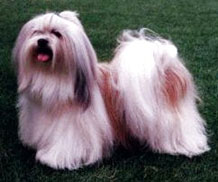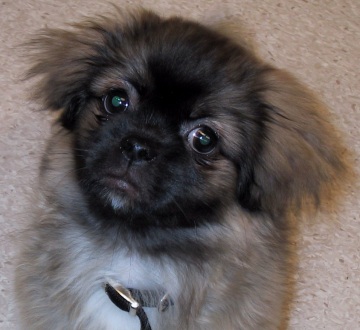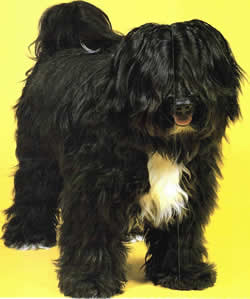|
These days, I have a Lhasa Apso. If you like big, working dogs, you might not think much of lapdogs. But consider this: small oriental dogs have been bred to be nice companions for centuries, even millennia. One major drawback to this breed is the grooming. I've solved that problem by cutting my dog's coat short. It might not look as pretty as the fancy show dogs, but it's far more practical. The Lhasa Apso was kept in monasteries and the
homes of wealthy Tibetans, as pets, as guard dogs and as good luck
charrns. Usually, the Lhasa Apso would sound the alarm, then the
huge and fierce Tibetan Mastiff would attack the intruder. With
its long coat, the apso would help warm its mistress from the cold. Once we went to a fenced in park area for dogs. Unfortunately, two Belgian Shepherds showed up. They took my sister's cairn terrier for prey and prepared to attack her. Seconds before they attacked, she turned around and faced them. The look in her eyes seemed to have sawed off their legs. They fell to the ground and grovelling, they apologogized to her. I'm not kidding. But they didn't see my apso. She was walking around,
sniffing the ground all by herself, right next to the other dogs.
She didn't even notice anything wrong. It was as if she was a little
angel even while she was still alive. I took my second apso to a puppy show once. She
did well, and could have done even better, if she hadn't been caught
at an unfortunate time. Worse, she had an indiscreet male behind
her. That was her litter brother, who now lives with us too. Even
if it hadn't been for that minor problem, both she and I were totally
exhausted afterwards. We decided not to go to any more shows. But
she's such a pretty little apso, and as far as I can tell, she's
quite close to the ideal. Apsos are really cute and very affectionate and loyal. However, they're also tiny, and I'm quite nervous something horrible is going to happen to her. Do I spoil her? Of course I do. And pamper her and make a big fuss about everything. Why not? She's my baby, and unlike human babies, she's not going to grow up and become a troublemaker in the future. Tibetan spaniels are very intelligent dogs
who originally came from Tibet. They used to be kept in the monasteries,
where they were highly valued by the monks. The dogs were used to
sound the alarm whenever an intruder or visitor approached. These
characteristics are still present in today's dog. The breed makes an excellent family dog. They're
very affectionate towards their moms or dads, but they can be a
bit shy around strangers.
They also served as alarm dogs in remote Tibetan
villages, alerting the Tibetan Mastiffs of intruders. Tibetans that
were too small for such a rigorous life were given to the lamas
and utilized and bred by the Tibetan monks for many centuries, developing
into Lhasa Apsos. The triad of shepherd, flock guard and herding
dog has worked as a partnership throughout the world and over the
centuries. None thrives alone in its sheep tending, so each has
learned to rely on the other. Ancient Tibetan natives conceived
this workable arrangement, with their Tibetan Mastiff doing the
guarding and the Tibetan Terrier taking care of the actual herding.
As the barbarians of the East invaded Europe, their families and
flocks came with them, along with their two types of dogs. These
Mastiffs and herders were left in all countries which absorbed these
migrations, where they became individualized for the local region. While the Tibetan Terrier of past centuries was tousled and shaggy-coated, today's show dog is adorned by an elegant coat necessitating hours of skillful grooming. Their long, elegant tails wrap protectively around themselves while sleeping. Another charming characteristic is that of using their paws in a catlike manner, holding, grasping and batting at balls. They can be stubborn if pushed into compliance. The Tibetan makes a merry household pet, small enough for apartments and sturdy enough for children's roughhousing. |
 My
first apso was, if possible, even cuter and sweeter than the one
I have now. She used to get on my knee when I was crying, and sniff
my wet face inquiringly and thoughtfully. That made it pretty much
impossible to continue crying.
My
first apso was, if possible, even cuter and sweeter than the one
I have now. She used to get on my knee when I was crying, and sniff
my wet face inquiringly and thoughtfully. That made it pretty much
impossible to continue crying. 
 Despite
his name, this ancient Tibetan is not a terrier, but a true herding
dog. The spunky little animal developed through ancient breeds,
the North KunLun Mountain Dog and the Inner Mongolian Dog, which
resembled a Poodle and stemmed back to the owtcharkas. Others believe
this breed to be one of the prototypes of the herding family.
Despite
his name, this ancient Tibetan is not a terrier, but a true herding
dog. The spunky little animal developed through ancient breeds,
the North KunLun Mountain Dog and the Inner Mongolian Dog, which
resembled a Poodle and stemmed back to the owtcharkas. Others believe
this breed to be one of the prototypes of the herding family.